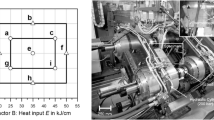The mechanical properties of the crack tip are vital for material safety evaluation. The weld material of welded joints is prone to work hardening during processing and installation, which changes the material mechanical properties and seriously affects the safety assessment of nuclear power welded joints. At the same time, nuclear power pipelines will creep under high temperatures and cause changes in the mechanical field at the crack tip. This paper obtains the mechanical properties of nickel-based alloy 182 in a nuclear power water environment. With the help of ABAQUS software, the change rules of the crack tip stress field and creep field under different hardening degrees are analyzed, and then the influence on crack tip creep and crack propagation rate is analyzed. Results show that increasing pre-hardening will increase the Mises stress around the crack tip, and the creep around the crack tip is expressed under pre-deformation, indicating that pre-hardening can accelerate the cracking of stress corrosion to a certain extent. Research has shown that the work hardening induced by the pre-deformation has an important influence on the creep rate at the crack tip, and the high creep zone is mainly concentrated in the direction of crack propagation. Under a certain work hardening rate, the crack growth will be accumulated.










Similar content being viewed by others
References
P. L. Andresen, “A brief history of environmental cracking in hot water,” Corrosion, 75, No. 3, 240–253 (2019).
L. Dong, C. Ma, Q. Peng, et al., “Microstructure and stress corrosion cracking of an SA508-309L/308L-316L dissimilar metal weld joint in primary pressurized water reactor environment,” J Mater Sci Technol, 40, 1–14 (2020).
S. Yamazaki, Z. Lu, Y. Ito, et al., “The effect of prior deformation on stress corrosion cracking growth rates of Alloy 600 materials in a simulated pressurized water reactor primary water,” Corros Sci, 50, No. 3, 835–846 (2008).
Y. L. Fan, H. L. Yang, “Influence of work hardening at critical water temperature on driving force of stress corrosion cracking crack growth for nuclear grade 316L stainless steel,” Forging and Stamping Technology, 12, 210–215(2021).
J. L. Zhang, Z. Y. Jiang, S. Y. Mu, et al., “Creep property and crack tip creep field analysis of nickel base alloy 600,” Strength Mater, 55, No. 2, 384–390 (2023). https://doi.org/10.1007/s11223-023-00532-5
K. Li, X. He, T. Wang, et al., “Effect of pre-compression on creep behavior of cracked tip,” Hot Working Technology, No. 24, 55–58 (2018).
M. Kamaya and T. Haruna, “Influence of local stress on initiation behavior of stress corrosion cracking for sensitized 304 stainless steel,” Corros Sci, 49, No. 8, 3303–3324 (2007).
J. Hou, Q. J. Peng, Z. P. Lu, et al., “Effects of cold working degrees on grain boundary characters and strain concentration at grain boundaries in alloy 600,” Corros Sci, 53, No. 3, 1137–1142 (2011).
F. J. Meng, B. Wu, Y. H. Lv, et al., “Effect of surface scratch on corrosion behavior of alloy 690TT heat exchanger tubes,” Chin J Mater Res, No. 11, 827–834 (2021).
Y. Yoo, X. Yan, F. Wang, et al., “Mechanisms of mitigating chloride-induced stress corrosion cracking of austenitic steels by laser shock peening,” Corrosion, 78, No. 6, 494–502 (2022).
C. Ma, Q. J. Peng, E. H. Han, and W. Ke, “Review of stress corrosion cracking of structural materials in nuclear power plants,” J Chinese Society for Corrosion and Protection, No. 1, 37–45 (2014).
S. Liu, G. Xu, Y. Li, et al., “Enhanced strength and corrosion resistance of creep-aged AA2050 Al-Li alloy by pre-rolling deformation,” Mater Design, 226, 111621(2023).
K. Arioka, T. Yamada, T. Terachi, et al., “Cold work and temperature dependence of stress corrosion crack growth of austenitic stainless steels in hydrogenated and oxygenated high-temperature water,” Corrosion, 63, No. 12, 1114–1123 (2007).
D. Du, K. Chen, H. Lu, et al., “Effects of chloride and oxygen on stress corrosion cracking of cold worked 316/316L austenitic stainless steel in high temperature water,” Corros Sci, 110, 134–142 (2016).
P. L. Andresen, “Environmentally assisted growth rate response of nonsensitized AISI 316 grade stainless steels in high temperature water,” Corrosion, 44, No. 7, 450–460 (1988).
Y. Yi and G. Was, “Stress and temperature dependence of creep in Alloy 600 in primary water,” Metall Mater Trans A, 32, 2553–2560 (2001).
GB/T228.2-2015. Metallic Materials – Tensile Testing – Part 2: Method of Test at Elevated Temperature (2016).
R. W. Bosch and M. Vankeerberghen, “Differentiation of SCC susceptibility with EIS of alloy 182 in high temperature water,” Corros Mater Degrad, 2, No. 3, 341–359 (2021).
N. N. Han and J. F. Gu, “Creep behavior of Inconel 600 alloy used for nuclear power,” Heat Treat Metal, No. 6, 103 (2016).
ASTM E399-90. Standard Test Method for Plane-Strain Fracture Toughness of Metallic Materials, ASTM International (2002).
H. Xue and T. Shoji, “Quantitative prediction of EAC crack growth rate of sensitized type 304 stainless steel in boiling water reactor environments based on EPFEM,” J Press Vess-T ASME, 129, No. 3, 460–467 (2007).
Author information
Authors and Affiliations
Corresponding author
Additional information
Translated from Problemy Mitsnosti, No. 1, p. 128, January – February, 2024.
Rights and permissions
Springer Nature or its licensor (e.g. a society or other partner) holds exclusive rights to this article under a publishing agreement with the author(s) or other rightsholder(s); author self-archiving of the accepted manuscript version of this article is solely governed by the terms of such publishing agreement and applicable law.
About this article
Cite this article
Wen, X.J., Yue, L.M. Analysis of Material Hardening Effect on the SCC Creep Characteristics Around the Crack Tip in the Welding Zone. Strength Mater (2024). https://doi.org/10.1007/s11223-024-00634-8
Received:
Published:
DOI: https://doi.org/10.1007/s11223-024-00634-8




